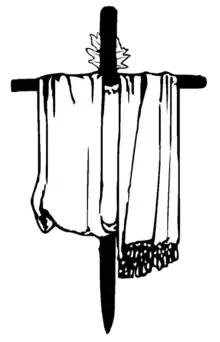
Several tagas can be seen on the right in this 2008 photograph of a tarmida initiation ceremony in Baghdad.
| Part of a series on |
| Mandaeism |
|---|
 |
| Religion portal |
In Mandaeism, the taga (Classical Mandaic: ࡕࡀࡂࡀ) is a white crown traditionally made of silk that is used during Mandaean religious rituals. The taga is a white crown which always takes on masculine symbolism, while the klila (myrtle wreath) is a feminine symbol that complements the taga.[1][2]
Use in rituals
Along with the klila, the taga is used during most Mandaean rituals, including masbuta, masiqta, and priest initiation rituals.[3]
In the Qolasta
Several prayers in the Qolasta are recited when consecrating and putting on the taga.[4]
See also
References
- ↑ Buckley, Jorunn Jacobsen (2002). The Mandaeans: ancient texts and modern people. New York: Oxford University Press. ISBN 0-19-515385-5. OCLC 65198443.
- ↑ Buckley, Jorunn Jacobsen (1989). "Why Once Is Not Enough: Mandaean Baptism (Maṣbuta) as an Example of a Repeated Ritual". History of Religions. University of Chicago Press. 29 (1): 23–34. doi:10.1086/463169. ISSN 0018-2710. JSTOR 1062837. S2CID 161224842.
- ↑ Drower, Ethel Stefana (1937). The Mandaeans of Iraq and Iran. Oxford at the Clarendon Press.
- ↑ Drower, E. S. (1959). The Canonical Prayerbook of the Mandaeans. Leiden: E. J. Brill.
This article is issued from Wikipedia. The text is licensed under Creative Commons - Attribution - Sharealike. Additional terms may apply for the media files.
